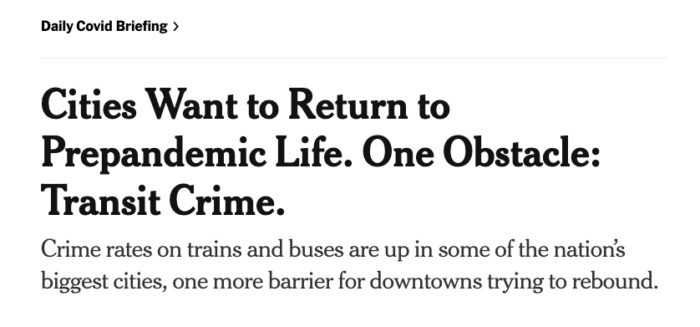Whenever you read a news article in an influential publication, ask: “How is this article changing the thing that it claims to be passively describing?”
A recent New York Times story leads with fears of transit crime but waits until paragraph 5 to explain the math that shows that their own article is making things worse. Here is the headline:
Here is fifth paragraph that most people won’t read:
Low ridership has left many passengers saying they feel more vulnerable than before. In Philadelphia, the number of certain serious crimes reported on public transit is higher than before the pandemic, and in New York about equal to previous levels, even though ridership in both places is significantly lower. In other cities, there are fewer crimes being reported than in 2019, but the crime rate is up because there are so few passengers. [emphasis added]
So in most cities:
- Crime is down but crime/rider is up simply because ridership is down.
- We can expect crime/rider to fall as ridership goes up, because, as the NYT itself says, low ridership makes passengers more vulnerable because they are more likely to be alone. A more crowded vehicle is safer (both absolutely and per passenger) because there are more potential witnesses, which tends to deter crime.
In this situation, the NYTimes decision to lead with the fear and bury the math is worsening the problem it claims to describe. The effect of the article is to scare people away from transit, so that ridership stays low, so that crime/rider stays high, so that they can do more articles about how scary public transit is.

NYTs fearmongering is unacceptable. Respectable journalists should put statistics and numbers in the proper context to help the readers understand them. The takeaway should be a optimistic outlook and a signal to everyone to retake the public space that everyone avoided because of Covid-19. It is easier to reach critical mass if people can trust that they are not the only ones using public transit again.